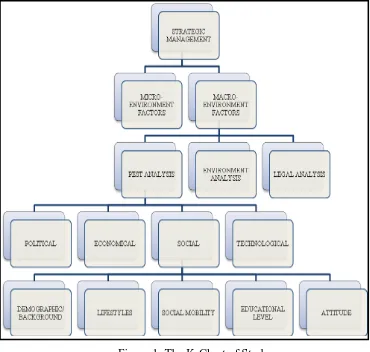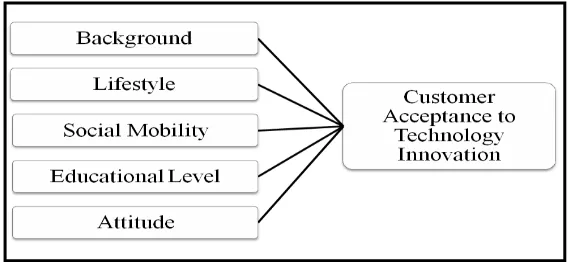SOCIAL IMPACT OF CONSUMER ACCEPTANCE TO TECHNOLOGY INNOVATION IN MELAKA
NOOR EMMA BINTI ISMAIL
ii DECLARATION
“I hereby declare that the work in this project is my own except for quotations and
summaries which have been duly acknowledged”
iii DEDICATION
Special dedication to my family members especially both of my parents who always give me encouragement in my life, my study and to finish my undergraduate project
To my supervisor
Puan Nor Ratna Masrom
To my Academic Advisor Puan Nor Azan Abd Gani
To all FPTT’s lecturers
To all my classmates
And all my friends out there
Thank you for your supporting and teaching.
Thank you for everything that you gave during my
studies and the knowledge that we shared.
iv ACKNOWLEDGEMENT
I would like to extend my deepest appreciation to my final year project supervisor Puan Nor Ratna Masrom for her valuable suggestions and guidance and also being very patient and understanding with me throughout the process of completing this project. Without her advice, gentle guidance, wise and helpful suggestions this project could not have been completed within the time-frame allocated. May God bless you for a job well done and many happy fruitful years in the future. I also sincerely thanks for the time spent proof reading and correcting my mistakes.
Secondly, a special thank to my beloved family also with my parent’s financial aids, because without their full support and prayers for me, I will never going trough out this study successfully. Thank you for your prayers and love. I cannot find the appropriate words that could properly describe my appreciation for their devotion, support and faith in my ability to attain my goals.
Special thank should also be given to all those individuals who assist me in one way or another in realising this study to its present form. Thanks to all my course mates that had been very supportive and helpful throughout my learning in the university. Thank you for your memorable and valuable friendships.
v ABSTRACT
vi ABSTRAK
vii TABLE OF CONTENTS
CHAPTER TOPIC PAGE
DECLARATION ii
DEDICATION iii
ACKNOWLEDGEMENT iv
ABSTRACT v
ABSTRAK vi
TABLE OF CONTENTS xi
LIST OF FIGURES xii
LIST OF TABLES xiv
LIST OF SYMBOL xiv
LIST OF APPENDICES xv
NOMENCLATURES xvi
CHAPTER 1 INTRODUCTION 1
1.1 Introduction 1
1.2 Problem Statement 2
1.3 Aim 3
1.4 Objective 3
viii
CHAPTER TOPIC PAGE
1.6 Limitation 4
1.7 Theoretical Framework 5
1.8 Summary 8
CHAPTER 2 LITERATURE REVIEW 9
2.1 Introduction 9
2.2 The Theoretical Concept of
Marketing Environment 10
2.2.1 Internal-Environment 10 2.2.2 Micro - Environment 11 2.2.3 Macro - Environment 11 2.3 The Theoretical Concept of PEST
Analysis 12
2.4 Theory and Application of Social Element in Macro-Environment
Factor 13
2.4.1 Background/ Demography 14
2.4.2 Lifestyle 14
2.4.3 Social Mobility 15
2.4.4 Educational Level 17
2.4.5 Attitude 17
2.5 Summary 18
CHAPTER 3 RESEARCH METHOD 19
3.1 Introduction 19
3.2 Research Design 20
ix
CHAPTER TOPIC PAGE
3.4 Primary and Secondary Data
Resource 22
3.5 Location of Research 22
3.6 Method of Primary Data Collection 23 3.7 Validity, Generalisability and
Reliability 24
3.8 Correlation Analysis 27
3.8 Summary 29
CHAPTER 4 RESULT AND DISCUSSION 30
4.1 Introduction 30
4.2 Demographic Analysis 31
4.2.1 Respondents Analysis 31
4.3 Frequency Analysis 34
4.3.1 Result 35
4.3.1.1 Background 35
4.3.1.2 Lifestyle 36
4.3.1.3 Social Mobility 36
4.3.1.4 Educational Level 37
4.3.1.5 Attitude 37
x
CHAPTER TOPIC PAGE
4.4 Reliability and Validity 39
4.5 The examination of social construct
in a PEST analysis 40
4.5.1 Descriptive Analysis 40
4.6 The Examination of Relationship between Social Factors with Customer Acceptance to
Technology Innovation 44
4.6.1 Pearson Correlation 44
4.7 The Investigation of the Highest Factor Influencing Customer
Acceptance to Technology Innovations 46 4.7.1 Linear Regression Analysis 46
4.8 Summary 57
CHAPTER 5 CONCLUSION AND
RECOMMENDATION 58
5.1 Summary of Findings 58
5.2 Recommendation for Future
Research 62
5.3 Conclusion 64
REFERENCES 65
xi LIST OF FIGURE
NO TITLE PAGE
1 The K-Chart of Study 5
2 Social Construct in PEST Analysis 6
xii LIST OF TABLE
NO TITLE PAGE
1 Index Davis 27
2 Interpretation of Mean Score 28
3 Respondent’s Gender 31
4 Respondent’s Age 31
5 Respondent’s Status of Employment 31
6 Respondent’s Level of Education 32
7 Respondent’s Income Level 32
8 Respondent’s Level of Knowledge of Technology
Innovation 33
9 Respondent’s Usage of Technology Innovation 33
10 Degree of Agreement 34
11 Percentage of Agreement for Background Variable 35 12 Percentage of Agreement for Lifestyle Variable 36 13 Percentage of Agreement for Social Mobility Variable 36 14 Percentage of Agreement for Educational Level Variable 37 15 Percentage of Agreement for Attitude Variable 38
xiii
NO TITLE PAGE
17 Descriptive Statistics of Background Variable 40 18 Descriptive Statistics of Lifestyle Variable 41 19 Descriptive Statistics of Social Mobility Variable 41 20 Descriptive Statistics of Educational Level Variable 42 21 Descriptive Statistics of Attitude Variable 42
22 Overall Variables Descriptive Statistics 43
23 Correlations 44
24 Model Summary of Background Variable 46
25 Coefficientsa Analysis of Background Variable 46
26 Model Summary of Lifestyle Variable 48
27 Coefficientsa Analysis of Lifestyle Variable 48
28 Model Summary of Social Mobility Variable 50
29 Coefficientsa Analysis of Social Mobility Variable 50 30 Model Summary of Educational Level Variable 52 31 Coefficientsa Analysis of Educational Level Variable 52
32 Model Summary of Attitude Variable 54
33 Coefficientsa Analysis of Attitude Variable 54
34 Model Summary of Overall Variables 56
xiv LIST OF SYMBOL
P = Significant value
β = Beta
≤ = Less than and equal to
≥ = Higher than and equal to
% = Percentage
N = Total numbers
R = Coefficient of correlation R² = Coefficient of determination
xv LIST OF APPENDICES
TITLE PAGE
APPENDIX A Gantt Charts 69
APPENDIX B Research Questionnaire 71
xvi NOMENCLATURE
UTeM Universiti Teknikal Malaysia Melaka UTC Urban Transformation Centre
1 CHAPTER 1
INTRODUCTION
1.1 Introduction
Consumer adoption of technology innovation has in most countries been even faster than ever (Perlado and Barwise 2005). Increasing the ratio of local production to local consumption from 48 percent to 57 percent as the face of increasing demand for innovation activities, the subscription of technology is most priority. PEST analysis in marketing environment helps in giving better understanding to user regarding determinants of technology usage and adoption. It has shown to significantly improve the prediction of intentions to adopt high-tech products where this model enhances adding social constructs in their perspective in order to account for the effects from others rather than from one's own thoughts and feelings.
2 the relationships between background variables and attitude toward technology innovation. Nowadays, innovation is not just need to be innovative in the area of innovation itself anymore, but beyond innovation lay disruptive innovation, which actually change social practices-the way we live, work and learn (Chesbrough, 2003). (Saul, 2011) in the book on title Social Innovation, Inc : 5 Strategies For Driving Business Growth Through Social Change says that in declaration of new era, leading corporation especially technological one should have for transforming into social innovation as they think about the role of business in society. By then, it shows the successful paths to making social change work for the business and in turn staying relevant in the industry. (Weber, 2011) relationship between business and society is becoming ever more complex since world of technology is increasingly integrated and interdependent. So that, the market should re-examine such central issue as well as the social aspect in term of the role of business in society. (Wiebe E. Bijker, 2012) in their book explain about social construction of large technological system wider in its manner and larger display on why they matter.
1.2 Problem Statement
3 What can be seen now, the general acceptance regarding innovation of technology in general but not specific especially in a social aspect. Specific here refers to explanation of factors of social that affecting the consumer acceptance of any technology innovation.
1.3 Aim
The aim of this research is to explore how social factors affect customer acceptance to technology innovation.
So, what this research going to explain about is how social conditions of customer will influence their acceptance to technology innovation which will be explained in details as social construct in PEST analysis.
1.4 Objectives
The objectives of the research are:
1. To examine social construct in PEST analysis.
2. To examine relationship between social construct in PEST analysis with customer acceptance to technology innovation. 3. To investigate the highest factor influencing customer acceptance
4 1.5 Scope
This research was conducted in Urban Transformation Centre (UTC) Bandar Melaka, so it will be focuses on the people there. Correspondents between the age of 15 and 45 years old will be recruited to participate in this research. Based on the calculation, estimation of population of 1,600 visitors of UTC every day, taking about 95% confidence level as well as 10 confidence interval found that samples size needed for this research are as many as 91 samples. A sample of 125 will be randomly selected from a pool of potential visitor who involved directly or indirectly in the purchasing of technology innovation goods. The study is limited to 15-45 years old only, as the primary research question is about how the influence of the social aspect, and specifically seeks to understand adult’s knowledge of these issues. The participant population will not be limited by race or ethnicity in this study.
1.6 Limitation
5 1.7 Theoretical Framework
[image:21.595.152.522.257.609.2]In this chapter, there is a theoretical framework that researcher think should be considered to explore the extent to technology innovation acceptance by consumers. In learning contexts can provide insights into the patterns of user that we see in term of social. The theoretical framework considers this within the current debate about the user adoption to and appropriate new technologies.
6 Figure 2: Social Construct in PEST Analysis
[image:22.595.194.478.344.475.2]7 1.7.1 Hypothesis
H0 : There is no relationship between background factor and customer acceptance to technology innovation.
H1 : There is relationship between background factor and customer acceptance to technology innovation.
H0 : There is no relationship between lifestyles factor and customer acceptance to technology innovation.
H1 : There is relationship between lifestyles factor and customer acceptance to technology innovation.
H0 : There is no relationship between social mobility factor and customer acceptance to technology innovation.
H1 : There is relationship between social mobility factor and customer acceptance to technology innovation.
H0 : There is no relationship between educational level factor and customer acceptance to technology innovation.
H1 : There is relationship between educational level factor and customer acceptance to technology innovation.
H0 : There is no relationship between attitudes factor and customer acceptance to technology innovation.
8

